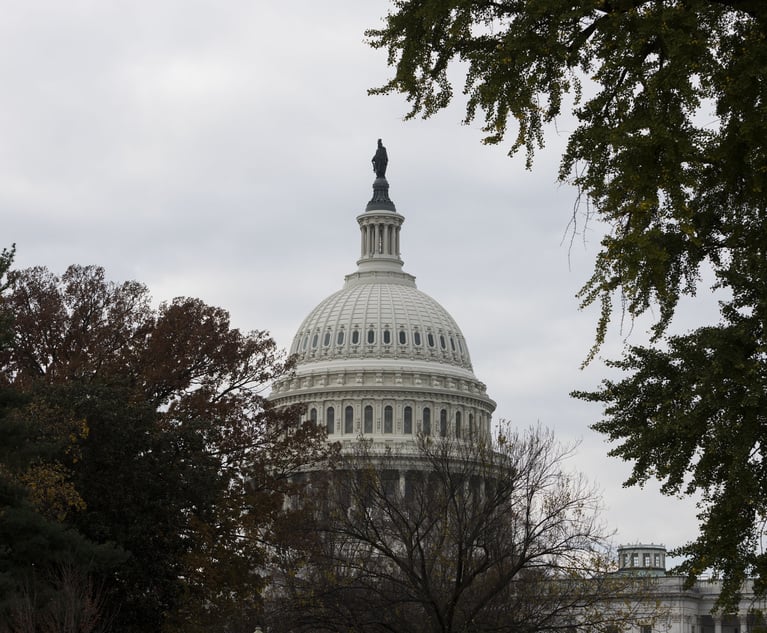ABA Report Shines Spotlight on Legal Deserts
Nearly one-third of U.S. counties have fewer than 1 lawyer per 1,000 residents. Compare that to New York City, with 14 lawyers for every 1,000 residents
July 28, 2020 at 12:01 AM
3 minute read

The American Bar Association is calling attention to the uneven distribution of lawyers across the United States in its second annual deep dive into the shape of the legal profession, adding a geographic dimension to the burgeoning industrywide discussion of the access to justice gap.
The figures on "legal deserts" are the lead entry and one of two new tranches of data in the ABA's second Profile of the Legal Profession, released Tuesday. They land at a time when a number of states are looking into updating how they regulate lawyers with the goal of insuring greater representation for individuals in need.
Out of over 3,100 counties and their equivalents nationwide, 52 lack a single lawyer. Nearly 1,300 have fewer than one lawyer per 1,000 residents. Compare this to national average of four lawyers per 1,000 residents, or New York City, home to 14 lawyers per 1,000 residents.
"Simply having lawyers in a county doesn't guarantee they are available to the public," the report said. "Many lawyers work for prosecutors, public defenders, city and county attorneys—and many others work for corporations or nonprofits. Numbers alone don't always tell the full story, but they are a starting place for discussion."
Even the three states with more lawyers than any others—New York, California and Texas—contain counties with less than one lawyer per 1,000 residents. California, which has been at the vanguard of discussions about regulatory reform, has seven such counties, while San Francisco County has a whopping 23 attorneys per 1,000 residents.
The issue is just as pronounced in lower-population states with large rural expanses. Ten of Arizona's 15 counties have less than one lawyer per 1,000 residents, and the state's overall figure of 2.1 lawyers per 1,000 residents is the lowest in the nation. Perhaps it should not be surprising that an Arizona task force has already proposed the elimination of rules barring outside ownership of law firms. Likewise, Utah, which with 2.6 lawyers per 1,000 residents is in the bottom third nationwide, has introduced a "regulatory sandbox" aimed at evaluating new legal service offerings, including nonlawyer-owned businesses.
The ABA also introduced new data on the growing burden of law school debt, which shows that nearly half of lawyers at the start of their careers surveyed said that they'd postponed or decided against having children because of their debts.
The report additionally resurfaces recent data on gender and racial equity within the law firm world. Nearly 10% of law firm partners in 2019 were Hispanic, African American, Asian, Native American or mixed race, compared to 2009, when the figure was 6%, according to data from the National Association For Law Placement. Meanwhile 21% of all equity partners were female. Women of color remain underrepresented, however, serving as only 5% of non-equity partners and 3% of equity partners.
Furthermore, of 103 female lawyers of color surveyed in 2019, 70% reported leaving or considering leaving the legal profession, according to an ABA report released in June.
|Read More
Uninformed or Underwhelming? Most Lawyers Aren't Seeing AI's Value
This content has been archived. It is available through our partners, LexisNexis® and Bloomberg Law.
To view this content, please continue to their sites.
Not a Lexis Subscriber?
Subscribe Now
Not a Bloomberg Law Subscriber?
Subscribe Now
NOT FOR REPRINT
© 2025 ALM Global, LLC, All Rights Reserved. Request academic re-use from www.copyright.com. All other uses, submit a request to [email protected]. For more information visit Asset & Logo Licensing.
You Might Like
View All


Fenwick and Baker & Hostetler Add DC Partners, as Venable and Brownstein Hire Policy Advisers
2 minute read
After Nearly 2 Decades in the Role, Longtime Haynes and Boone General Counsel Passes the Baton
3 minute readTrending Stories
Who Got The Work
Michael G. Bongiorno, Andrew Scott Dulberg and Elizabeth E. Driscoll from Wilmer Cutler Pickering Hale and Dorr have stepped in to represent Symbotic Inc., an A.I.-enabled technology platform that focuses on increasing supply chain efficiency, and other defendants in a pending shareholder derivative lawsuit. The case, filed Oct. 2 in Massachusetts District Court by the Brown Law Firm on behalf of Stephen Austen, accuses certain officers and directors of misleading investors in regard to Symbotic's potential for margin growth by failing to disclose that the company was not equipped to timely deploy its systems or manage expenses through project delays. The case, assigned to U.S. District Judge Nathaniel M. Gorton, is 1:24-cv-12522, Austen v. Cohen et al.
Who Got The Work
Edmund Polubinski and Marie Killmond of Davis Polk & Wardwell have entered appearances for data platform software development company MongoDB and other defendants in a pending shareholder derivative lawsuit. The action, filed Oct. 7 in New York Southern District Court by the Brown Law Firm, accuses the company's directors and/or officers of falsely expressing confidence in the company’s restructuring of its sales incentive plan and downplaying the severity of decreases in its upfront commitments. The case is 1:24-cv-07594, Roy v. Ittycheria et al.
Who Got The Work
Amy O. Bruchs and Kurt F. Ellison of Michael Best & Friedrich have entered appearances for Epic Systems Corp. in a pending employment discrimination lawsuit. The suit was filed Sept. 7 in Wisconsin Western District Court by Levine Eisberner LLC and Siri & Glimstad on behalf of a project manager who claims that he was wrongfully terminated after applying for a religious exemption to the defendant's COVID-19 vaccine mandate. The case, assigned to U.S. Magistrate Judge Anita Marie Boor, is 3:24-cv-00630, Secker, Nathan v. Epic Systems Corporation.
Who Got The Work
David X. Sullivan, Thomas J. Finn and Gregory A. Hall from McCarter & English have entered appearances for Sunrun Installation Services in a pending civil rights lawsuit. The complaint was filed Sept. 4 in Connecticut District Court by attorney Robert M. Berke on behalf of former employee George Edward Steins, who was arrested and charged with employing an unregistered home improvement salesperson. The complaint alleges that had Sunrun informed the Connecticut Department of Consumer Protection that the plaintiff's employment had ended in 2017 and that he no longer held Sunrun's home improvement contractor license, he would not have been hit with charges, which were dismissed in May 2024. The case, assigned to U.S. District Judge Jeffrey A. Meyer, is 3:24-cv-01423, Steins v. Sunrun, Inc. et al.
Who Got The Work
Greenberg Traurig shareholder Joshua L. Raskin has entered an appearance for boohoo.com UK Ltd. in a pending patent infringement lawsuit. The suit, filed Sept. 3 in Texas Eastern District Court by Rozier Hardt McDonough on behalf of Alto Dynamics, asserts five patents related to an online shopping platform. The case, assigned to U.S. District Judge Rodney Gilstrap, is 2:24-cv-00719, Alto Dynamics, LLC v. boohoo.com UK Limited.
Featured Firms
Law Offices of Gary Martin Hays & Associates, P.C.
(470) 294-1674
Law Offices of Mark E. Salomone
(857) 444-6468
Smith & Hassler
(713) 739-1250









